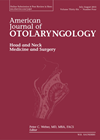You searched for "Adolescence"
Person-centred care, enhancing audiology student understanding across the globe
4 July 2024
| Charlotte Rogers
|
ENTA - Audiology - Adult
Over 200 students registered for a multinational virtual event facilitated by the Ida Institute. The aim was to determine levels of student understanding and approaches to person-centred care (PCC), alongside the opportunity to evaluate the benefits of this approach to...
Prophylactic swallowing exercises in head and neck cancer
1 May 2015
| Roganie Govender
Clinicians working in head and neck cancer will be familiar with the increased interest in prophylactic swallowing exercises to reduce the devastating impact of dysphagia experienced by patients undergoing radiation or chemo-radiation therapy. This study from Denmark is one of...
Adjuvant radiotherapy for T4N0 laryngeal cancers treated with laryngectomy
6 November 2024
| Christopher Burgess
|
ENTA - Laryngology / Swallowing / Voice
A total laryngectomy remains the gold standard for the initial treatment of advanced (T4) squamous cell carcinomas of the larynx without evidence of distant disease. Adjuvant radiotherapy (RT) is also recommended for such cancers. In the absence of other adverse...
Sleep apnoea got your heart in your throat? Perhaps it’s time to ditch the CPAP and fetch the scalpel
7 January 2025
| Thomas William Binnersley
|
ENTA - Laryngology / Swallowing / Voice
The link between obstructive sleep apnoea (OSA) and cardiovascular disease (CVD) is clear. Its well-established association with essential hypertension is thought to link OSA to an increased risk of atherosclerotic and hypertensive sequelae. However, data on the long-term impact of...
Migraine related vertigo
Migraine is one of the commonest conditions an otologist will have to manage with up to half of migraineurs displaying vestibular symptoms. David Selvadurai provides an overview and management plan for this increasingly well recognised disorder. Migraine is a common...Implants and the identity of self
4 September 2023
|
ENTA - Audiology - Adult, ENTA - Auditory Implants
Hearpeers is MED-EL’s international community for people with hearing implants and those considering getting a hearing implant, as well as their families and friends. This group enables people to connect with hearing implant recipients from around the world to learn...
Random-pattern skin flaps: part 1 – advancement flaps
In the first of a short series covering random pattern skin flaps and their use in clinical practice (see Part 2 here, Part 3 here and Part 4 here), Christopher Thompson and Miles Bannister describe in some detail their techniques...Medicine and Seamus Heaney
1 January 2015
| Ray Clarke
|
ENTA - ENT
Seamus Heaney grew up in the 1940s. Infectious diseases – diphtheria, poliomyelitis, mumps, measles and rubella – were rife. Stepping Stones recalled talk among older neighbours of ‘a-waiting on’ when they were close to death. Aunts and uncles succumbed to...
The role of the multidisciplinary team in laryngology and airway – the Charing Cross experience
30 April 2020
| Anthony Rotman, Lindsay Lovell, Justin Roe, Margaret Ashcroft, Andrew Holroyd, Chadwan Al Yaghchi, Guri Sandhu
|
ENTA - ENT, ENTA - Laryngology / Swallowing / Voice
As the National Centre for Airway Reconstruction, the Charing Cross laryngology MDT provides expert care to patients with airway problems as well as voice and swallowing disorders. In this article, the team explain their raison d’etre and why the MDT...
Imaging tinnitus
Tinnitus is a common sensation with a reported prevalence of 7-32%. The British National Study of Hearing recorded that 10% of adults suffered from prolong spontaneous tinnitus, and approximately a quarter of these are subsequently referred to hospital for investigation...Multifrequency tympanometry
1 March 2019
| Leigh Martin
|
ENTA - Audiology - Adult, ENTA - Audiology - Paediatric, ENTA - Audiology - Diagnostic
There are many good reasons to start using multifrequency tympanometry as opposed to a traditional, single 226Hz probe tone. Here, Leigh Martin of Interacoustics discusses the uses and benefits. Tympanometry is a core test in the audiologist’s test battery. In...








